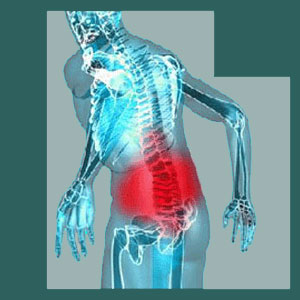
Sacroiliac lower back pain presents diagnostic challenges for many caregivers, since patients may experience pain in a diversity of locations. In fact, many sacroiliac joint pain syndromes are mistakenly blamed on coincidental lumbar spinal abnormities, while others are incorrectly attributed to hip degeneration or piriformis pain syndromes.
In other cases, the sacroiliac joint is unfairly blamed for being the source of symptoms due to some form of structural or functional irregularity, while all along the real culprit for pain is the lumbar spine, hip or piriformis muscle.
This essay explores the confusion between sacroiliac, lumbar, hip and piriformis pain conditions and why their similarities often create problematic misdiagnosis issues of the patient.
Sacroiliac Lower Back Pain Symptoms
The sacroiliac joint is a long anatomical joining of the sacrum and the pelvic ilium. This joint features many tissues that traverse the sacroiliac or connect around it, including the infamous piriformis muscle and sciatic nerve. Since part of the joint is actually the lower spinal segment known as the sacrum and since the other part of the joint is where the hip resides, it is easy to see why symptoms in the SIJ are difficult to pinpoint anatomically.
Symptoms of sacroiliac pain can mimic those of many lower back pain conditions, some spinal conditions, hip pathologies, piriformis pain syndromes and even sciatica expressions. Pain might exist more towards the lower back and buttocks, more towards the frontal pelvis, more deeply seated in the hip joint or radiating into the legs.
Misdiagnosed Lower Back Pain
A significant percentage of sacroiliac joint pain problems might never be discovered and instead be blamed on alternate anatomical locations, especially when diagnostic evidence of structural changes supports this supposition. Additionally, many cases of pain that might seem to be experienced in the sacroiliac joint actually come from a completely different source, including all of the following possible symptomatic origins:
The lower back is the region of the spine most affected by age and activity-related degeneration. The lower back is also susceptible to injury and the most common location for these occurrences is right at the joining of the lumbar spine and the sacrum, called the lumbosacral juncture. This is also basically exactly where the sacroiliac joint resides. Unilateral sacroiliac lower back pain is often incorrectly identified as unilateral lumbar pain, while bilateral sacroiliac lower back pain is often misdiagnosed as bilateral lumbar pain. Of course, the opposite form of misdiagnosis is also possible with true spinal pain being unjustly blamed on the SIJ.
Sacroiliac joint pain can be misidentified as hip degeneration and this verdict is typically bolstered by medical imaging evidence of arthritic activity in the hip joint. However, it is crucial to remember that hip deterioration is normal and universal in adults. Most of the structural changes noted on medical imaging evaluations will be considered typical. Alternatively, some hip pathologies are mistakenly diagnosed as residing in the sacroiliac joint.
Piriformis syndrome can create the same type of pseudo-sciatica that can be enacted by the tissues around the sacroiliac joint. Injury to the piriformis muscle can also produce pain that closely resembles the type of symptoms common to several sacroiliac diagnoses, including pain when mobilizing the leg or bearing weight.
Remember that true sacroiliac joint pain can take many forms and might radiate into the lower back, pelvis, hips, buttocks or legs, making it difficult to differentiate from all these alternative pain syndrome explanations. Patients are warned to be proactive in their diagnostic efforts and never agree to treatment until they have evidence-based certainly that their diagnostic verdict is accurate.
Sacroiliac Joint Pain > Sacroiliac Pain > Sacroiliac Lower Back Pain





